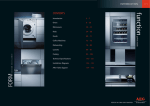Download AEG Electrolux KB9810E User manual
Transcript
KB9810E User manual Electric built-in oven 2 Contents Thank you for choosing one of our high-quality products. To ensure optimal and regular performance of your appliance please read this instruction manual carefully. It will enable you to navigate all processes perfectly and most efficiently. To refer to this manual any time you need to, we recommend you to keep it in a safe place. And please pass it to any future owner of the appliance. We wish you much joy with your new appliance. Contents Operating instructions 2 Safety information Electrical safety Children's safety Safety during use Microwave How to avoid damage to the appliance 2 3 3 3 3 4 Do not use the appliance 5 Description of product 6 General view 6 Control panel 6 Oven layout 7 Accessories Oven 7 Before using for the first time 8 Setting and changing the time 8 Cleaning for the first time 9 Getting to know the appliance 9 Operating the oven 10 Oven Functions 12 Inserting the oven shelf and baking tray 16 Additional functions 17 Clock functions 19 Other functions 25 Usage, tables and tips 26 Baking Roasting Single Economy Grill Rotitherm cooking Defrosting Drying Making preserves Microwave Programmes Cleaning and care The outside of the appliance Oven interior Accessories Side rails Oven lighting If something is wrong… 26 31 33 33 34 34 35 36 43 45 46 46 46 46 47 47 Installation instructions Safety instructions for the installer Disposal 48 49 53 Customer service Guarantee/Customer Service GREAT BRITAIN & IRELAND European Guarantee 53 54 54 55 www.electrolux.com 55 Subject to change without notice Operating instructions Safety information Important safety instructions! Safety information 3 Read carefully and keep for future use! Electrical safety • This appliance must only be connected by a qualified installation engineer . • In the event of a fault or damage to the appliance: Take the fuses out or switch off. • Should the door seal and the door seal surfaces be damaged, the appliance must not be operated until they are repaired. • Repairs to the appliance must only be carried out by qualified service engineers . Considerable danger may result from improper repairs. If repairs become necessary, please contact our Customer Care Department or your dealer. Children's safety • Small children must be kept away from the appliance. Make sure that children do not touch the appliance when playing. • Always heat baby food in jars or bottles with the lid or top off. After heating, stir or shake well, so that the heat is equally distributed. Before you give the baby food to the child, please be sure to test the temperature. • When operating the grill (alone or in combination with the microwave) the viewing window becomes hot. Therefore keep small children away from the door of the appliance. • Never leave children unsupervised while the appliance is operating. • This appliance is fitted with a child safety device. Safety during use • This appliance should be used only for normal domestic cooking, roasting and baking of food. • Be careful if connecting electrical appliances to sockets near to this appliance. Electrical leads must not be caught under the hot oven door. • Warning: Risk of burns! The interior surfaces of the oven become very hot during use. • If you use ingredients containing alcohol in the oven, a slightly flammable mixture of alcohol and air may ensue. In this case, be careful when opening the door. Do not handle any sources of heat, sparks or naked flames when doing so. • People (including children), who, because of their physical, sensory or mental capabilities or their inexperience or ignorance, are not able to use the appliance safely, should not use this appliance without supervision by or instruction from a responsible person. Information on acrylamides According to the latest scientific knowledge, intensive browning of food, especially in products containing starch, can constitute a health risk due to acrylamides. Therefore we recommend cooking at the lowest possible temperatures and not browning foods too much. Microwave • Only switch the appliance on when there is food inside it. With no food in it, the appliance could be overloaded. • Only use microwave safe cookware (see section Uses, Tables and Tips: Suitable cookware and materials). • To protect the interior or the door of the appliance from corrosion through escaping steam (condensed water), please dry the appliance thoroughly with a cloth after each use. 4 Safety information • Do not leave the appliance unattended, if food is being heated or cooked in disposable containers made of plastic, paper or other flammable materials. • If smoke appears, keep the appliance closed. Switch off the appliance and disconnect from the power supply. Do not use the appliance under any circumstances, if it is no longer working correctly. • When heating liquids always put a coffee spoon or a glass rod in the container to avoid boiling delay. With boiling delay the boiling temperature is reached without the typical steam bubbles rising. If the container is shaken even slightly the liquid can suddenly boil over or spray violently. Risk of burns! • Prick food with "skin" or "peel", such as potatoes, tomatoes, sausages, with a fork several times before cooking so that the food does not burst. • Ensure that a minimum temperature of 70°C is reached when cooking/heating food. For this please refer to the power and time data in the tables. Never use mercury or liquid thermometers to measure the temperature of the food. 70 • Foods heated with microwaves give off heat to the cookware. Use oven gloves or min 70 C something similar! 0 • Do not overcook the dishes by using powers and times that are too high. The food can dry out, burn or set itself alight in certain places. • The interior of the oven, the grill heating element and the accessories become hot when the appliance is operating. Please be careful when handling them and use oven gloves or similar for this reason. Risk of burns! • Metal objects must be at least 2 cm from the walls of the oven interior and the oven door. Otherwise spark discharges may be caused and the appliance can be damaged • If not advised otherwise, do not use aluminium foil. • Do not get anything caught between the door and the door frame. • Always keep the door seal, the door seal surfaces and the interior clean. Lack of cleanliness in the appliance can lead to dangerous situations. • Do not store any flammable materials inside the oven. These could ignite when the oven is switched on. How to avoid damage to the appliance • Do not line the oven with aluminium foil and do not place a baking tray or saucepan etc. on the floor, as otherwise the oven enamel will be damaged by the heat build-up. • Fruit juices dripping from the baking tray will leave stains, which you will not be able to remove. For very moist cakes, use a deep tray. Safety information 5 • Do not put any strain on the oven door when open. • Never pour water directly into the oven when it is hot. This could cause damage to and discoloration of the enamel. • Rough handling, especially around the edges of the front panel, can cause the glass to break. • Do not store any flammable materials inside the oven. These could ignite when the oven is switched on. • Do not store any moist foods inside the oven. This could cause damage to the enamel. • Do not leave dishes uncovered in the oven after switching off the cooling fan. Moisture may form inside the oven or on the glass door and also get onto the units. Information on the oven enamel Changes to the colour of the oven's enamel surface as a result of use do not affect the appliance's suitability for normal and correct use. They therefore do not constitute a defect in terms of warranty law. Do not use the appliance ... for cooking eggs in their shells (with fried eggs, pierce the yolks first) and snails, as otherwise these burst. Cooking oil (fondue, deep frying) and drinks with high alcohol content: Spontaneous ignition! Risk of explosion! ... for heating tightly closed containers, e. g. tins, bottles, screw top jars. ... for drying animals, textiles, grain pillows and gel cushions and other flammable materials: Risk of fire! ... for cookware made of porcelain, ceramic or earthenware that has small holes, e. g. on handles or unglazed bottoms. Moisture penetrating holes can cause the cookware to crack when it is heated. 6 Description of product Description of product General view 1 2 3 1 Control Panel 2 Door handle 3 Full glass door Control panel 1 2 1 Oven displays Description of product 2 Oven functions buttons Oven layout 1 2 7 3 3 2 4 1 5 6 1 2 3 4 5 6 7 Grill element Microwave generator Light in the oven Rear heating panel Oven lighting Glass base, removable Side rails, removable Oven shelf levels Accessories Oven Oven shelf For cookware, cake tins, roasts and grilling food. 7 8 Before using for the first time Baking tray For cakes and biscuits. (not suitable for microwave mode) Before using for the first time Setting and changing the time The oven only operates when the time has been set. When the appliance has been connected to the electrical supply or when there has been a power cut, the symbol for the time automatically flashes. 1. To change a time that has already been set, press the clock functions button repeatedly until the symbol for the time flashes. 2. Using the time. or button, set the current After approx. 5 seconds, the flashing stops and the clock displays the time set. The appliance is now ready to use. The time can only be modified, if the child safety device is deactivated, none of the clock functions Countdown , Cook Time or End Time and none of the oven functions are set. Before using for the first time 9 Cleaning for the first time Before you use the oven for the first time, you should clean it thoroughly. Do not use any sharp or abrasive cleaning tools or materials! These could damage the surface. For metal fronts, use normal commercially available cleaning agents. 1. Open the oven door. The lighting in the oven is switched on. 2. Remove all accessories and side rails and clean with a warm solution of water and washing-up liquid. 3. Also wipe the oven out with a warm solution of water and washing-up liquid and then dry it. 4. Wipe the front of the appliance with a damp cloth. Getting to know the appliance The appliance can be operated in test mode to test or demonstrate all operating steps. The oven does not heat up. Test mode Switching on 1. Switch off the appliance using the Stop button . 2. Press and hold the Baking/Roasting Programmes buttons and at the same time until a signal sounds and "d" lights up in the display. Switching test mode off 1. Switch off the appliance using the Stop button . 2. Press and hold the Baking/Roasting Programmes buttons and at the same time until a signal sounds and "d" goes out in the display. 10 Operating the oven Operating the oven The electronic oven controls The display field 1 2 3 8 1 2 3 4 5 6 7 8 4 7 6 5 Memory: P / Test: d Microwave function Temperature/Time/Microwave Power Weight display Time functions Length of operation Thermometer symbol Baking/Roasting Programmes Oven functions The control panel 1 8 1 Start button 2 3 7 4 6 5 Operating the oven 2 3 4 5 6 7 8 11 Microwave button Fast Warm Up Stop button / Restore settings Clock functions Selector buttons Baking/Roasting Programmes Oven functions General instructions • Always confirm the selected function with the Start button . If the selected function is not started within 30 seconds, the appliance switches itself off. • When the selected function is started, the oven begins to heat up or the time set begins to count down. • If the oven door is opened during operation, the function stops. After closing the door continue with the Start button . If the Start button is not started within 30 seconds, the appliance switches itself off. • The oven light is switched on as soon as an oven function is started or the oven door is opened. The oven light goes off after 10 minutes when the door is open and the appliance switched off. • Stop operation with the Stop button, continue operation with the Start button . Switch the appliance off by pressing the Stop button again. Selecting the oven function 1. Press the or button repeatedly until the desired oven function appears. – A suggested temperature appears in the temperature display. 2. Press the Start button to start the function that has been set. Changing the oven temperature Press the or button to raise or lower the temperature. The setting changes in 5 °C steps. 12 Operating the oven Thermometer symbol • The slowly rising thermometer symbol indicates how far the oven has heated up. • The three segments of the thermometer symbol flashing one after the other show that Fast Warm Up is on. Switching the oven off To switch the oven off, press the Stop button repeatedly until only the time and any residual heat is displayed. Cooling fan The fan switches on automatically to keep the appliance surfaces cool. When the oven is switched off, the fan continues to run to cool the appliance down and then switches itself off. Fast Warm Up After an oven function has been selected, the empty oven can be pre-heated in a relatively short time using the additional function Fast Warm Up. CAUTION! Please do not put the food to be cooked into the oven, until Fast Warm Up is completed and the oven is operating using the desired function. 1. Set desired oven function. If necessary, change the suggested temperature. 2. Press the Fast Warm Up button . The symbol for lights up. When the bars flash one after another this shows that Fast Warm Up is operating. When the temperature set is reached, the bars of the heat indicator are lit. A signal sounds. The symbol for goes out. The oven now continues heating according to the pre-set oven function and temperature. You can now place the food in the oven. Oven Functions Oven function Use Fan oven with circular For roasting and baking on up to two levels at the same heating element time. Rotitherm roasting For roasting larger pieces of meat or poultry on one oven level. The function is also suitable for gratinating and browning the top of dishes. Single economy grill For grilling flat foodstuffs and for toasting . Defrosting/drying To defrost or dry herbs, fruit and vegetables. Microwave In microwave mode, the heat is created directly in the food. For heating ready meals and drinks, for defrosting meat or fruit and for cooking vegetables and fish. Combi Function Operating the oven 13 For the style of heating for the oven function(s), the Microwave function can be switched on The dishes are cooked in the shortest time and browned at the same time. Quick Start Microwave Quick Start of the maximum microwave power when the appliance is switched off using the Start button . Operating time from 30 seconds to 7 minutes. Each press of the button adds 30 seconds to the operating time displayed. Microwave 1. Switch off the appliance using the Stop button, if necessary. 2. By repeatedly pressing the Microwave button, set the desired microwave power. – The settings options are in 100 Watt steps from 1,000 Watt to 100 Watt. – Repeatedly pressing the Microwave button makes the power display begin again at 1,000 Watt. 3. Using the or button, set the desired cook time. The symbol for Cook Time flashes. – The cooking times can be set as follows: – from 0 to 2 min. in 5 second steps, – from 2 to 5 min. in 10 second steps, – from 5 to 10 min. in 20 second steps, – from 10 to 20 min. in 30 second steps, – from 20 min. onwards in 1 minute steps. – The maximum length of operation that can be set is: – At 700 Watt to 1,000 Watt 0 to 7 min. 40 seconds, – at 100 Watt to 600 Watt 0 to 59 min. 4. When the Start button is pressed, the time set begins to count down. The symbol for Cook Time lights up. – While the time counts down, the power can be changed using the Microwave button. 14 Operating the oven – While the time counts down, using the clock functions buttons and the cooking time can be increased or reduced. When the time has elapsed, a signal sounds for 2 minutes. The microwave switches itself off. The symbol for Cook Time flashes and the time display appears. To turn off the signal: Press any button. Combi Function You will find a selection of dishes in the chapter "Uses, Tables and Tips: Combi Function. 1. Switch off the appliance using the Stop button, if necessary. 2. Press the or button repeatedly until the desired oven function appears. 3. Using the or button set the desired temperature. 4. By repeatedly pressing the Microwave button, set the desired microwave power (max. 600 Watt). 5. Using the or button, set the desired cook time. The symbol for Cook Time flashes. – The cooking times can be set as follows: – from 0 to 2 min. in 5 second steps, – from 2 to 5 min. in 10 second steps, – from 5 to 10 min. in 20 second steps, – from 10 to 20 min. in 30 second steps, – from 20 min. onwards in 1 minute steps. The maximum length of operation that can be set is 59 min. Operating the oven 15 6. When the Start button is pressed, the time set begins to count down. Oven and microwave are on. The symbol for Cook Time lights up. – While the time counts down, the power can be changed using the Microwave button. – While the time counts down, using the and buttons the cooking time can be increased or reduced. When the time has elapsed, a signal sounds for 2 minutes. The appliance switches itself off. The symbol for Cook Time flashes and the time display appears. To turn off the signal: Press any button. Microwave Quick Start 1. Switch off the appliance using the Stop button, if necessary. 2. Press the Start button repeatedly until the desired period of operation appears. The appliance switches itself on at maximum microwave power. – Each press of the button adds 30 seconds to the cooking time displayed. Maximum 7 min. at maximum microwave power. – While the time counts down, using the clock functions buttons and the cooking time can be increased or reduced. – By repeatedly pressing the Microwave button , the microwave power can be changed. – By pressing the Stop button once, operation can be interrupted. Continue operation using the Start button . Pressing the Stop button twice switches the appliance off. 16 Operating the oven When the time has elapsed, a signal sounds for 2 minutes. The appliance switches itself off. The symbol for Cook Time flashes and the time display appears. To turn off the signal: Press any button. Information on power settings The overview indicates at which power setting certain processes can be performed. The powers given are guidelines. Microwave Power Suitable for 1,000 Watt 900 Watt 800 Watt 700 Watt • • • • • Heating liquids Searing at the beginning of a cooking process Cooking vegetables Cooking foodstuffs Melting gelatine and butter 600 Watt 500 Watt • • • • Defrosting and heating frozen meals Heating one-plate meals Simmering stews Cooking egg dishes 400 Watt 300 Watt 200 Watt • • • • • • Continuing to cook meals Cooking delicate foodstuffs Heating baby food Simmering rice Heating delicate foods Melting cheese 100 Watt • • • • • Defrosting meat, fish, bread Defrosting cheese, cream, butter Defrosting fruit and cakes (gateaux) Raising yeast dough Warming up cold dishes and drinks Inserting the oven shelf and baking tray Shelf runner safety and anti-tip device To increase shelf runner safety, all insertable components have a small curved indentation at the bottom on the right and left-hand edge. Always insert insertable components so that this indentation is at the back of the oven interior. This indentation is also important for preventing the insertable components from tipping. Operating the oven 17 Baking tray : Push the baking tray between the guide bars of the selected oven level. Oven shelf : Insert the oven shelf so that the feet point downwards. Push the oven shelf between the guide bars of the selected oven level. The high rim around the oven shelf is an additional device to prevent cookware from slipping off. Additional functions Microwave Programmes For this function, use the pre-set programmes (see section "Uses, Tables and Tips: Programmes). Selecting a programme 1. Switch off the appliance using the Stop button, if necessary. 2. Press the Baking/Roasting Programmes button then press the or button repeatedly, until the desired programme appears in the display (P1 to P12). – In the display the preset weight "gr" is displayed. The symbol for Cook Time flashes. Weight = Cook Time 18 Operating the oven 3. By pressing the button or , the weight display can be adapted to the weight of the food, minimum 100 g, maximum 1,500 g (P 5 to P12 maximum 1,000 g). – Inputting the weight automatically controls the length of time the microwave operates. – Always input the lower weight, e. g. bread weighs 460 g: Set the weight to 400 g. 4. When the Start button is pressed, the time set begins to count down. The symbol for Cook Time and "min" light up. – When the time has elapsed, a signal sounds for 2 minutes. The oven switches itself off. The symbol for Cook Time flashes. With some programmes, after the time has elapsed a Keep Warm function is started. A signal sounds and "HH" lights up in the display. After the Keep Warm function has ended, a signal sounds for 2 minutes. The oven switches itself off. The symbol for Cook Time flashes and the time display appears. To turn off the signal: Press any button. Memory function The Memory function can be used to save one setting which is used very frequently. 1. Set oven function, temperature and the clock functions Cook Time and/or End Time , if necessary . Operating the oven 2. Press and hold the Baking/Roasting Programmes button for approx 2 seconds until a signal sounds. The setting is saved. 3. Continue by pressing the Start button or switch the appliance off using the Stop button . To save another setting, press the Baking/ Roasting Programmes button for approx. 2 seconds. The previously saved setting is replaced by the new one. Starting the Memory function 1. Switch off the appliance using the Stop button, if necessary. 2. Use the Baking/Roasting Programmes button to call up the saved setting. 3. Press the Start button . Clock functions 2 1 3 4 5 6 1 Clock functions 2 Clock displays 19 20 Operating the oven 3 Time 4 Cook Time/End Time/Operating Time 5 Clock functions 6 Selector buttons Countdown To set a countdown. When it has counted down, a signal sounds. This function has no effect on the operation of the microwave and oven. min. Microwave Cook Time For setting how long the microwave is to operate. Cook Time To set how long the oven is to operate. End Time For setting when the oven is to switch itself off again. Time To set, change or find out the time (see section Before using for the first time). General instructions • After a clock function has been selected, the corresponding symbol flashes for about. 5 seconds. During this period, the desired times can be set or modified using the or button. • When the desired time has been set, the symbol continues to flash for approx. 5 seconds. After this the symbol lights up. The set Countdown begins to count down. • The time set for Cook Time and End Time begins to count down after the selected function starts. Countdown 1. Press the clock functions button repeatedly until the symbol for Countdown flashes. Operating the oven 2. Using the or button, set the desired Countdown (max. 99.00 minutes). After approx. 5 seconds the display shows the time remaining. The symbol for Countdown lights up. When the time has elapsed, a signal sounds for 2 minutes. "0.00" lights up and the symbol for Countdown flashes. To turn off the signal: Press any button. Microwave Cook Time min. 1. Select microwave function and set power by repeatedly pressing the Microwave button . 21 22 Operating the oven 2. Using the or button set the desired cooking time. The symbol for Cook Time flashes. 3. When the Start button is pressed, the time set begins to count down. The symbol for Cook Time lights up. By repeatedly pressing the clock functions button the current time can be found out. While the time counts down, using the and buttons the cooking time can be increased or reduced. When the time has elapsed, a signal sounds for 2 minutes. The oven switches itself off. "0.00" is displayed and the symbol for Cook Time flashes. To turn off the signal: Press any button. Cook Time 1. Select oven function and using the or button select the temperature. 2. Press the clock functions button repeatedly until the symbol for Cook Time flashes. Operating the oven 3. Using the or cooking time. button set the desired 4. When the Start button is pressed, the time set begins to count down. The symbol for Cook Time lights up. By repeatedly pressing the clock functions button the current time can be found out. When the time has elapsed, a signal sounds for 2 minutes. The oven switches itself off. "0.00" is displayed and the symbol for Cook Time flashes. To turn off the signal: Press any button. End Time 1. Select oven function and using the or button select the temperature. 2. Press the clock functions button repeatedly until the symbol for End Time flashes. 23 24 Operating the oven 3. Using the or switch-off time. button, set the desired The symbols for End Time and Cook Time light up. The oven switches itself on automatically. By repeatedly pressing the clock functions button the current time can be found out. When the time has elapsed, a signal sounds for 2 minutes. The oven switches itself off. "0.00" is displayed and the symbols for End Time and Cook Time flash To turn off the signal: Press any button. Cook Time and End Time combined Cook Time and End Time can be used simultaneously, if the oven is to be switched on and off automatically at a later time . 1. Select oven function and temperature. 2. Using the Cook Time function , set the time required for cooking the dish, e. g. 1 hour. Operating the oven 25 3. Using the End Time function , set the time at which the dish is to be ready, e. g. at 14:05. The symbols for Cook Time and End Time light up. The oven switches itself on automatically at the time calculated, e. g. at 13:05. When the set cook time has elapsed, a signal sounds for 2 minutes and the oven switches itself off, e. g. at 14:05. Other functions Switching off the display You can save energy by switching off the display. Switching off the display 1. Switch off the appliance using the Stop button, if necessary. Residual heat must not be displayed. 2. Press the clock functions buttons and at the same time until the display goes out. As soon as the appliance is operated again, the display automatically switches itself on. When the appliance is next switched off, the display goes out again. To have the time permanently displayed again, you must switch the display on again. Switching on the display 1. Switch off the appliance using the Stop button, if necessary. 2. Press the clock functions buttons and at the same time until the display appears again Child safety device As soon as the child safety device is activated, it is no longer possible to operate the oven. 26 Usage, tables and tips Switching on the child safety device 1. Switch off the appliance using the Stop button, if necessary. An oven function must not be selected. 2. Press and hold the Baking/Roasting Programme buttons and at the same time, until SAFE appears in the display. The child safety device is now activated. Switching off the child safety device 1. Switch off the appliance using the Stop button, if necessary. 2. Press and hold the Baking/Roasting Programme buttons and at the same time, until SAFE goes out in the display. The child safety device is now deactivated and the appliance is again ready for use. Button Beep Switching off button beep 1. Switch off the appliance using the Stop button, if necessary. 2. Press and hold the and buttons at the same time, until a signal sounds (approx. 2 seconds). The button beep is now switched off. Switching on button beep Press and hold the and buttons at the same time, until a signal sounds (approx. 2 seconds). The button beep is switched on again. Automatic switch-off If the oven is not switched off after a certain time, or if the temperature is not modified, it switches off automatically. The last temperature set flashes in the temperature display. The oven switches itself off at an oven temperature of: 30 - 120° C after 12.5 hours 120 - 200° C after 8.5 hours 200 - 250° C after 5.5 hours OFF appears in the display. Starting up after an automatic switch-off Switch the oven off completely. It can then be operated again. Usage, tables and tips Baking Oven function: Fan oven with ring heating element Baking tins Usage, tables and tips 27 • Light coloured metal baking tins are suitable for fan oven cooking with ring heating . element Oven levels , you can bake on up to two baking • Using the fan oven with ring heating element trays at the same time: 1 baking tray: e.g. oven level 2 2 2 1 1 4 4 2 2 1 baking tin: e.g. oven level 1 2 baking trays: e.g. oven levels 2 and 4 General instructions , you can also bake with two baking With fan oven cooking using ring heating element tins next to one another on the oven shelf at the same time. This only slightly increases the baking time. When using frozen food, the trays may warp during the cooking process. This is caused by the large temperature difference between the frozen food and the oven temperature. After the trays have cooled, the warping disappears. Notes on the baking tables The following tables give the required temperature settings, cooking times and oven levels for a selection of dishes. • Temperatures and baking times are for guideline purposes only since these will depend on the consistency and amount of mixture and the type of baking tin used. • We recommend using the lower temperature the first time and then using a higher temperature if necessary, for example, when a deeper browning is required or the baking time is taking too long. • If you cannot find the settings for a particular recipe of your own, look for the one that is most similar. 28 Usage, tables and tips • Extend the baking time by 10-15 minutes if you are baking cakes on baking trays or in tins on more than one level. • Moist cakes and pastries, such as fruit flans or pizzas, are baked on one level. • Differences in the height of the items being baked may cause differences in the degree of browning at the beginning of the baking process. If this occurs, you should not change the temperature setting . Different rates of browning even out as baking progresses. • Your new oven may bake or roast differently from your previous appliance. If this is the case, adjust your normal settings (temperature, cooking times) and oven levels to those recommended in the following tables. If the baking times are longer, you can switch the oven off about 10 minutes before the end of baking time to make use of the residual heat. Unless otherwise stated, the values given in the tables assume that cooking is started when the oven is cold. Baking table Baking on one oven level Type of baking Fan oven with ring heating element Shelf position Temperature °C Time in hrs: mins. Ring cake or brioche 1 160-170 0:50-1:10 Madeira cake/Fruit cakes 1 150-170 1:10-1:30 Sponge cake 1 160-180 0:25-0:40 Flan base - shortcrust pastry 2 170-190 0:10-0:25 Flan base - sponge mixture 2 150-170 0:20-0:25 Apple tart (covered) 1 160-180 0:50-1:00 Apple pie (2 tins, Ø 20cm, placed diagonally) 1 180-190 1:05-1:20 Spicy flan (e.g. Quiche Lorraine) 2 170-190 0:30-1:10 Cheesecake 1 160-180 1:00-1:30 Plaited bread/bread crown 1 160-180 0:30-0:40 Christmas cake 1 160-180 0:40-1:00 Bread (rye bread) 1 180-200 0:45-0:60 Cream puffs/éclairs 2 170-190 0:30-0:40 Swiss Roll 2 200-220 1) 0:08-0:15 Cake with crumble topping (dry) 2 160-180 0:20-0:40 Butter/sugar cake 2 170-190 1) 0:15-0:30 Fruit flan (made with yeast dough/sponge mixture) 2 160-180 0:25-0:50 Baking in tins Cakes/pastries/breads on baking trays Usage, tables and tips 29 Baking on one oven level Type of baking Fan oven with ring heating element Fruit flan made with shortcrust pastry Shelf position Temperature °C Time in hrs: mins. 2 170-190 0:40-1:20 Yeast cakes with delicate toppings (e.g. curd 2 cheese, cream, vanilla cream) 150-170 0:40-1:20 Pizza (with a lot of topping) 2 190-210 1) 0:20-0:40 Pizza (thin crust) 2 230 1) 0:12-0:20 Flat bread 2 230 1) 0:10-0:20 Swiss flaky pastry tarts 2 190-210 0:35-0:50 Short pastry biscuits 2 160-180 0:06-0:20 Viennese whirls 2 160 0:10-0:40 Biscuits made with sponge mixture 2 160-180 0:15-0:20 Pastries made with egg white, meringues 2 80-100 2:00-2:30 Macaroons 2 100-120 0:30-0:60 Fancy yeast biscuits 2 160-180 0:20-0:40 Puff pastries 2 180-200 1) 0:20-0:30 Rolls 2 210-230 0:20-0:35 Small cakes (20 per tray) 2 Biscuits 170 1) 0:20-0:30 1) Pre-heat oven Baking on more than one oven level Type of baking Fan oven with ring heating element Temperature in °C Time in hrs: Min. Oven level from the bottom 2 levels Biscuits Short pastry biscuits 2/4 160-180 0:15-0:35 Viennese whirls 2/4 160 0:20-0:60 Biscuits made with sponge mixture 2/4 160-180 0:25-0:40 Pastries made with egg white, meringues 2/4 80-100 2:10-2:50 Macaroons 2/4 100-120 0:40-1:20 Danish pastries 2/4 160-180 0:30-0:60 30 Usage, tables and tips Baking on more than one oven level Type of baking Fan oven with ring heating element Temperature in °C Time in hrs: Min. Oven level from the bottom 2 levels Puff pastries 2/4 0:30-0:50 180-200 1) 1) Pre-heat oven. Tips for baking Baking results Possible cause Remedy The cake is not browned enough at the bottom Wrong oven level used Place cake lower in the oven The cake sinks (becomes soggy, lumpy, streaky) Oven temperature too high Use a slightly lower temperature setting Baking time too short Bake for longer. Baking times cannot be reduced by setting the oven temperatures higher Too much liquid in the mixture Use less liquid. Pay attention to mixing times, especially if using mixing machines Temperature is too low Use a higher oven temperature setting Baking time is too long Reduce baking time Cake is too dry Cake browns unevenly Cake is not done within the baking time given Oven temperature is too high and Use a lower oven temperature setbaking time is too short ting and increase the baking time Cake mixture/dough is unevenly distributed Spread the mixture/dough evenly on the baking tray Temperature is too low Use a slightly higher oven temperature setting Soufflés and au gratin dishes Type of dish Fan oven with ring heating element Shelf position Temperature °C Time in hrs: Min. Pasta bake 1 180-200 0:45-1:00 Lasagne 1 180-200 0:25-0:40 Vegetables au gratin 1) 1 160-170 0:15-0:30 Baguettes au gratin 1) 1 160-170 0:15-0:30 Sweet bakes 1 180-200 0:40-0:60 Fish bakes 1 180-200 0:30-1:00 Usage, tables and tips Type of dish 31 Fan oven with ring heating element Shelf position Stuffed vegetables 1 Temperature °C 160-170 Time in hrs: Min. 0:30-1:00 1) Pre-heat oven Frozen ready meals chart Food to be cooked Oven function Frozen pizza Fan oven with ring heating element Chips 1) (300-600 g) Shelf position 3 Temperature °C Time as per manufacturer's instructions as per manufacturer's instructions Rotitherm roasting 3 200-220 as per manufacturer's instructions Baguettes Fan oven with ring heating element 3 as per manufacturer's instructions as per manufacturer's instructions Fruit cake Fan oven with ring heating element 3 as per manufacturer's instructions as per manufacturer's instructions 1) Turn chips 2 or 3 times during cooking Roasting Oven function: Fan oven with ring heating element Ovenware for roasting • Any heat-resistant ovenware is suitable to use for roasting. (Please follow the manufacturer's instructions.) • We recommend roasting all lean meats in a roasting tin or dish with a lid . The meat will be more succulent. • All types of meat that must be browned or that are to have crackling can be roasted in a roasting tin or dish without a lid . Tips on using the Roasting Table The information given in the following table is for guideline purposes only. • We only recommend roasting meat and fish weighing 1 kg or more in the oven. • To prevent meat juices escaping or fat from burning onto the pan, we recommend placing some liquid in the roasting cookware. • Turn the meat as required (after 1/2 - 2/3 of the cooking time). • Use the cooking juices to baste large roasts and poultry several times during the cooking time. This will give better roasting results. • Switch the oven off approx. 10 minutes before the end of roasting time to make use of the residual heat. 32 Usage, tables and tips Roasting Table Food to be roasted Fan oven with ring heating element Shelf position Temperature °C Time in hrs: mins. Pork shoulder, neck, ham joint (1,000-1,500g) 1 170-190 1:30-2:00 Chops,smoked loin of pork (1,000-1,500g) 1 180-200 1:00-1:30 Meat loaf (750-1,000 g) 1 180-200 0:45-1:00 Knuckle of pork (pre-cooked) (750-1,000g) 1 170-190 1:30-2:00 Pot roast (1,000-1,500 g) 1 180-200 Roast beef or sirloin, per cm of thickness 1 210-230 Pot roast (1,000-1,500 g) 1 170-190 1:30-2:00 Knuckle of veal (1500-2000 g) 1 170-190 2:00-2:30 Leg of lamb (1,000-1,500 g) 1 170-190 1:15-2:00 Saddle of lamb (1,000-1,500 g) 1 180-200 1:00-1:30 Beef 2:00-2:30 1) 0:06-0:09 min. per cm of thickness Veal Lamb Quick roast items cooked on a baking tray Sausages 'cordon bleu' 1 220-230 1) 0:05-0:08 Small sausages 1 220-230 1) 0:12-0:15 Boneless cutlet or chops, breaded 1 220-230 1) 0:15-0:20 Rissoles 1 210-220 1) 0:15-0:20 1 210-220 0:45-1:15 Chicken, spring chicken (1,000-1,500g) 1 190-210 0:45-1:15 Chicken half (per 400-500 g) 1 200-220 0:35-0:50 Poultry pieces (per 200-250 g) 1 200-220 0:35-0:50 Duck (1500-2000 g) 1 180-200 1:15-1:45 Saddle of hare, leg of hare (up to 1,000g) 1 220-230 1) 0:25-0:40 Saddle of venison (1,500-2,000 g) 210-220 1:15-1:45 Fish (steamed) Whole fish (1,000-1,500g) Poultry Game 1 Usage, tables and tips Food to be roasted 33 Fan oven with ring heating element Shelf position Leg of venison (1,500-2,000 g) 1 Temperature °C 200-210 Time in hrs: mins. 1:30-2:15 1) Pre-heat oven Single Economy Grill Oven function: Single economy grill with maximum temperature setting Always grill with the oven door closed. • For grilling, use both the oven shelf and the tray together. • The grilling times are guidelines Grilling Table Food to be grilled Oven level Grilling time 1st side 2nd side Slices of white bread 1) 3 6 - 8 mins. 3-5 mins. Toast with topping 2 8-10 mins. --- 1) Use the oven shelf without a tray Rotitherm cooking oven function: Rotitherm cooking Type of dish Temperature in °C Tray Oven shelf Shelf position Grilling time in minutes turn after… minutes. Chicken (900-1,000 g) 180-200 1 2 50-60 25-30 Stuffed rolled pork roast (2,000 g) 180-200 1 2 90-95 45 Pasta bake 180 --- 2 30 --- Potato au gratin 200 --- 2 20-23 --- Gnocchi, au gratin 180 --- 2 20-23 --- Cauliflower with Hollandaise 200 sauce --- 2 15 --- • Grilling is particularly suitable for flat pieces of meat or fish. • Normally pre-heat for about 3 minutes to cook flat pieces of meat and fish with the fanassisted grill. Then put the food to be grilled in as per the table. Put a baking tray with about 1 - 1.5 cm of water on level 1. CAUTION! Hot steam will also escape when the door is opened. 34 Usage, tables and tips Type of dish Temperature in °C Tray Oven shelf Shelf position Grilling time in minutes turn after… minutes. Rissoles 230 1 3 14-18 6-8 Pork fillet 230 1 2 16-22 6-10 Grilled sausages 230 1 3 14-18 6-8 Fillet steaks, veal steaks 230 1 3 11-13 5-6 Fillet of beef, roast beef (ap- 230 prox. 1 kg) 1 2 20-24 10-12 Defrosting Oven function: Defrosting/Drying (Temperature setting 30°C) • Unwrap the food and place it on a plate on the oven shelf. • Do not cover with a plate or bowl, as these can substantially lengthen the defrosting time. • For defrosting, place the shelf in the 1st oven level from the bottom . Defrosting Table Dish Defrosting time (mins.) Further defrosting time (mins.) Note Chicken, 1,000 g 100-140 20-30 Place chicken on an upturned saucer in a large plate. Turn halfway through Meat, 1,000 g 100-140 20-30 Turn halfway through Meat, 500 g 90-120 20-30 Turn halfway through Trout, 150 g 25-35 10-15 --- Strawberries, 300 g 30-40 10-20 --- Butter, 250 g 30-40 10-15 --- Cream, 2 x 200 g 80-100 10-15 Cream can also be whipped when still slightly frozen in places Gateau, 1400 g 60 60 --- Drying Oven function: Defrost/Drying • Use trays covered with greaseproof paper or baking parchment. • You will get a better result, if you switch the oven off halfway through the drying time, open the door and leave it to cool down, preferably overnight. Then finish drying the food to be dried. Food to be dried Temperature in °C Oven level 1 level 2 levels Time in hours (guideline) Usage, tables and tips Food to be dried Temperature in °C Oven level 35 Time in hours (guideline) Vegetables Beans 75 2 2/4 6-9 Peppers (slices) 75 2 2/4 5-8 Vegetables for soup 75 2 2/4 5-6 Mushrooms 50 2 2/4 6-9 Herbs 40-50 2 2/4 2-4 Plums 75 2 2/4 8-12 Apricots 75 2 2/4 8-12 Apple slices 75 2 2/4 6-9 Pears 75 2 2/4 9-13 Fruit Making preserves Oven function: Fan oven with ring heating element • When making preserves, only use commercially available preserving jars of the same size. • Jars with twist-off or bayonet type lids and metal tins are not suitable. • When making preserves, use the first shelf position from the bottom . • Use the baking tray for making preserves. There is enough room on this for up to six 1litre preserving jars. • The jars should all be filled to the same level and clamped shut. • Place the jars on the baking tray so that they are not touching one another. • Pour approx. 1/2 litre of water onto the baking tray so that sufficient moisture is produced in the oven. • As soon as the liquid in the first jars starts to simmer (after approx. 35-60 minutes with 1 litre jars), switch the oven off or reduce the temperature to 100°C. (See table). Preserves table Temperature in °C Cooking time until simmering in minutes. Continue to cook at 100°C (in minutes). Strawberries, blueberries, raspberries, ripe gooseberries 160-170 35-45 --- Unripe gooseberries 160-170 35-45 10-15 160-170 35-45 10-15 Carrots 2) 160-170 50-60 5-10 Cucumbers 160-170 50-60 --- Preserves 1) Berries Stone fruits Pears, quinces, plums Vegetables 36 Usage, tables and tips Temperature in °C Cooking time until simmering in minutes. Continue to cook at 100°C (in minutes). Mixed pickles 160-170 50-60 15 Turnips, peas, asparagus 160-170 50-60 15-20 Preserves 1) 1) The times and temperatures for making preserves are for guideline purposes only. 2) Leave standing in the oven after switching off Microwave Information about operation General • After switching off the appliance, let the food stand for a few minutes (see Microwave Tables: standing time). • Remove aluminium foil packaging, metal containers, etc. before preparing the food. Cooking • If possible, cook food covered with material suitable for use in the microwave. Only cook food uncovered, if a crust is to be kept. • Chilled or frozen foods require a longer cooking time. • Dishes containing sauce should be stirred from time to time. • Vegetables that have a firm structure, such as carrots, peas or cauliflower, should be cooked in water. • Turn larger pieces about halfway through the cooking time. • If possible, cut vegetables into similar sized pieces. • Use flat, wide dishes. Defrosting meat, poultry, fish • Place the frozen, unwrapped food on a small upturned plate with a container underneath or on a defrosting rack or plastic sieve so that the defrosting liquid can run off. • Turn the food after half the defrosting time. If possible, divide and then remove pieces that have started to defrost. Defrosting butter, portions of gateau, quark • Do not defrost completely in the appliance, but leave to defrost at room temperature. This gives a more even result. Remove any metal or aluminium packaging or -parts completely before defrosting. Defrosting fruit, vegetables • Do not completely defrost fruit and vegetables, which are to be further prepared while still raw, in the appliance, but at room temperature. • Fruit and vegetables that are to be cooked, can be cooked directly using a higher microwave power, without being defrosted. Ready Meals • Ready meals in metal packaging or plastic trays with metal covers may only be defrosted or heated in the microwave if these are expressively designated as suitable for use in the microwave. • You must follow the manufacturer's instructions printed on the packaging (e. g. remove metal cover and pierce plastic film). Usage, tables and tips 37 Suitable cookware and materials Cookware/Material Microwave Defrosting Ovenproof glass and porcelain (with no met- X al components, e. g. Pyrex, heatproof glass) Heating Cooking Single economy grill oven X X X -- -- -- Glass and glass ceramic made of ovenproof/ X frostproof material (e. g. g. Arcoflam), grill shelf X X X X X X -- X X X -- Cardboard, paper X -- -- -- Clingfilm X -- -- -- Roasting film with microwave safe closure X X X -- Roasting dishes made of metal, e. g. enamel, -cast iron -- -- X Baking tins, black lacquer or silicon-coated -- -- -- X Baking tray -- -- -- X X X -- X X X Non-ovenproof glass and porcelain 1) Ceramic 2), earthenware 2) Heat-resistant plastic up to 200°C 3) 3) 3) X Browning cookware, e. g. Crostino or Crunch -plate Ready meals in packaging 3) X 1) With no silver, gold, platinum or metal plating/decorations 2) Without quartz or metal components, no metalliferous glaze 3) Please observe the maximum temperatures quoted by the manufacturer! X suitable -- not suitable Other things to think about… • Foods have different shapes and qualities. They are prepared in different amounts. Therefore the necessary times and powers for defrosting, heating or cooking are all different. As a rough guide: Double the amount = almost double the time • When heating with the microwave the heat is produced in the food itself. For this reason all places cannot be heated at the same time. The heated dishes should therefore be stirred or turned, especially in the case of larger amounts of food. • The standing time is given in the tables. Let the food stand, in the appliance or outside it, so that the heat is distributed more evenly. • You get better results for rice using flat, wide dishes. 38 Usage, tables and tips Microwave Cooking Table Defrosting Dish Microwave Size (g) Power (Watts) Cook time min. Standing time (min.) Things to note Meat Whole cuts of meat 500 200 10-12 10-15 Turn halfway through Steak 200 200 3-5 5-10 Turn halfway through; remove defrosted parts Mixed minced meat 500 200 10-15 10-15 Turn halfway through; remove defrosted parts Goulash 500 200 10-15 10-15 Turn halfway through; remove defrosted parts Chicken 1000 200 25-30 10-20 Turn halfway through; cover defrosted parts with aluminium foil Chicken breast 100-200 200 3-5 10-15 Turn halfway through; cover defrosted parts with aluminium foil Chicken thighs 100-200 200 3-5 10-15 Turn halfway through; cover defrosted parts with aluminium foil Duck 2000 200 45-60 20-30 Turn halfway through; cover defrosted parts with aluminium foil Whole Fish 500 100 10-15 15-20 Turn halfway through Fish fillets 500 100 10-12 15-20 Turn halfway through 100 100 2-4 20-40 Turn halfway through Quark 250 100 10-15 25-30 Remove aluminium parts, turn halfway through Butter 250 100 3-5 15-20 Remove aluminium parts, turn halfway through Poultry Fish Sausage Sliced sausage Dairy products Usage, tables and tips 39 Defrosting Dish Microwave Size (g) Power (Watts) Cook time min. Standing time (min.) Things to note Cheese 250 100 3-5 30-60 Remove aluminium parts, turn halfway through Cream 200 100 7-12 20-30 Remove aluminium top, stir halfway through Yeast dough 1 piece 100 2-3 15-20 Turn plate halfway through Cheesecake 1 piece 100 2-4 15-20 Turn plate halfway through Cake (gateau) 1 piece 100 1-2 15-20 Turn plate halfway through Dry cake (e. g. Pound cake) 1 piece 100 2-4 15-20 Turn plate halfway through Fruit cake 1 piece 100 1-2 15-20 Turn plate halfway through Bread 1000 100 15-20 10-15 Turn halfway through Sliced bread 500 100 8-12 10-15 Turn halfway through Bread rolls 4 rolls 100 5-8 5-10 Turn halfway through Strawberries 300 100 8-12 10-15 Defrost covered, stir halfway through Plums, cherries, raspberries, blackcurrants, apricots 250 100 8-10 10-15 Defrost covered, stir halfway through Chocolate / Chocolate 150 coating 600 2-3 --- Stir halfway through Butter 100 200 2-4 --- Stir halfway through Baby food in jars 200 300 2-3 --- Stir halfway through; check temperature! Baby milk (bottle, 180 ml) 200 1000 0:200:40 --- Put spoon into bottle, stir and check temperature! Cakes/pastries Fruit Melting Heating 40 Usage, tables and tips Defrosting Dish Microwave Size (g) Power (Watts) Cook time min. Standing time (min.) Things to note Convenience food 400-500 600 4-6 5 Remove any aluminium lids, turn halfway through Frozen ready meals 400-500 400 14-20 5 Remove any aluminium lids, turn halfway through Milk 1 cup ap1000 prox. 200 ml 1:151:45 --- Put spoon in the container Water 1 cup ap1000 prox. 200 ml 1:30-2 --- Put spoon in the container Sauce 200 ml 600 1-2 --- Stir halfway through Soup 300 ml 600 2-4 --- Stir halfway through Cooking Dish Microwave Size (g) Power (Watts) Cook time min. Standing time (min.) Things to note Whole fish 500 500 8-10 --- Cook covered, turn container several times during cooking Fish fillets 500 500 6-8 --- Cook covered, turn container several times during cooking Vegetables, short cooking time, fresh 1) 500 600 12-16 --- Add approx. 50 ml water, cook covered, stir halfway through Vegetables, short cooking time, frozen 1) 500 600 14-18 --- Add approx. 50 ml water, cook covered, stir halfway through Vegetables, long cooking 500 time, fresh 1) 600 14-20 Vegetables, long cooking 500 time, frozen 1) 600 18-24 --- Add approx. 50 ml water, cook covered, stir halfway through Boiled potatoes 1000 5-7 300 W / 15- 20 Cook covered, stir halfway through 800 g + 600 ml Add approx. 50 ml water, cook covered, stir halfway through Usage, tables and tips 41 Cooking Dish Microwave Size (g) Rice 300 g + 600 ml Power (Watts) 1000 Cook time min. 4-6 Standing time (min.) --- Things to note Cook covered, stir halfway through 1) Cook all vegetables with a cover on the container. The times given are guidelines only and depend upon the type and qualities of the foodstuffs. Combi-Function Table Oven functions: Fan oven with circular heating element + microwave roasting Type of dish Baking/ roasting dishes Oven function Temp. in °C Microwave Watt + microwave Shelf position Time in min. or Rotitherm Remarks Bake / quark Gratin dish bake on oven shelf + 180 600 1 25-35 Bake/ Gratin Gratin dish on oven shelf + 180 600 1 30-40 Duck 2,000 g Glassware on rack + First 230 then 180 300 300 1 40-60 Turn after 15 min. then 180°C, 10 min. standing time Fish fillets 350 g Glassware on rack + 230 600 1 15-20 Stuffed, rolled, seasoned Fish gratin 1,400 g Glassware + 180 300 1 30-40 Poultry, whole Glassware on rack + 200 300 1 30-40 Turn after 20 min. Chicken halves Glassware on rack + 200 300 1 25-35 Turn after 15 min. Meatloaf 650g Glassware on rack + 180 300 1 30-40 5 min. standing time Chicken drumsticks Glassware on rack + 210 600 1 20-25 Turn after 15 min. Roast veal, 1,000 g Glassware on rack + 210 300 1 30-40 Turn after 25 mins., uncovered, 5 min. standing time Potato gratin Glassware on rack + 180 600 1 20-25 Put cheese on top 42 Usage, tables and tips Type of dish Baking/ roasting dishes Oven function Temp. in °C Leg of lamb with bone 1,000g Glassware on rack + 180 Leg of lamb, Glassware on boned rack 1,000g + Lasagne 1,200g Gratin dish on oven shelf Pasta bake 1,800g Microwave Watt Shelf position Time in min. Remarks 300 1 30-40 5 min. standing time 200 300 1 30-40 5 min. standing time + 230 400 1 25-30 Gratin dish on oven shelf + 230 400 1 30-35 Stir after 20 min. Stuffed pepper Glassware on rack + 230 400 1 20-25 Pepper halves with cheese/ vegetable filling Roast beef, 1,000 g Glassware on rack + 180 400 1 60-70 10 min. standing time, turn once, cook covered Roast pork, neck 1,200g Glassware on rack + 230 400 1 55-65 5 min. standing time, turn once The cooking times and temperatures are guidelines only and depend upon the type and qualities of the foodstuffs. Tips for the microwave Result Remedy You cannot find details for the amount of Look for a similar food. Increase or shorten the length food prepared. of the cooking times according to the following rule: Double the amount = almost double the time Half the amount = half the time The food has got too dry. Set shorter cooking time or select lower microwave power. The food is still not defrosted, hot or cooked after the time has elapsed. Set longer cooking time or select higher microwave power. Please note that taller dishes need longer. After the cooking time has elapsed, the food is overheated at the edge but is still not ready in the middle. Next time select a lower power and a longer time. Stir liquids, e. g. soup, halfway through. Test dishes in accordance with IEC 60705 (Microwave power 1,000 Watt) The quality and function of microwave appliances are tested by test institutes using special dishes. Usage, tables and tips Dish Power (Watts) Oven functions Oven level Cook Time min. Standing time (min.) 43 Note Egg custard (12.3.1) 300 Glass base 30-40 120 Turn dish once after half the time has elapsed Sponge mix (12.3.2) 600 Glass base 8-10 5 Cooking meat loaf (12.3.3) 500 Glass base 20-22 5 Potato gratin (12.3.4) 500 1 40 5 Cake (12.3.5) 200 2 20 5 Grilled chicken 300 1,200 g (12.3.6) 1 35 5 Turn after 15 min Defrosting mince (13.3.) 100 Glass base 15-20 5 Turn after half the time, remove defrosted parts Defrosting raspberries (B. 2.1) 100 Glass base 11-13 5 Cover Cover, turn dish once halfway through cooking time Programmes The appliance has 12 programmed functions, which can be selected one after the other using the Baking/Roasting Programmes button. For settings, see section Additional Functions: Microwave Programmes. Programme Function Recipe weight Time according to presetting Keep Warm function "HH" Presetting min. max. Poultry 1,000 g 100 g 1,500 g 19 min. 40 seconds, No P2 Meat 800 g 100 g 1,500 g 17 min. 36 seconds, No P3 Fish 1,000 g 100 g 1,500 g 15 min. 20 seconds, No P4 Bread 500 g 100 g 1,500 g 6 min. No P1 Defrosting 44 Usage, tables and tips Programme P5 Function weight Presetting min. max. Time according to presetting Keep Warm function "HH" Frozen Vegetables, small + 50 ml water 800 g 100 g 1,000 g 15 min. 44 seconds, Yes P6 Frozen Vegetables, large + 50 ml water 800 g 100 g 1,000 g 22 min. 56 seconds, Yes P7 Fresh vegetables, small + 50 ml water 800 g 100 g 1,000 g 24 min. No P8 Fresh vegetables, large + 50 ml water 800 g 100 g 1,000 g 26 min. 40 seconds, No P9 Potatoes + 100 ml water 600 g 100 g 1,000 g 17 min. 12 seconds, No P 10 Fish 1,000 g 100 g 1,000 g 21 min. 40 seconds, Yes Potato gratin 1,000 g 400 g 1,800 g 30 min. Yes Chicken 1,000 g 400 g 1,400 g 30 min. Yes P 11 Boiling Recipe Combi Function + P 12 + POTATO GRATIN (serves 4-5) Ingredients: • 750 g potatoes • 100 g Gruyère or Emmental cheese, grated • 1 egg • 75 ml milk or cream • 2 tablespoons butter Cleaning and care 45 • 1/2 tablespoon thyme • 1 clove of garlic, peeled • Salt, pepper, nutmeg Preparation: Peel potatoes, cut into approx. 3 mm thick slices, dry and then season with salt and pepper. Place half of the potato slices in a greased, oven-proof dish. Sprinkle some grated cheese over them. Layer the rest of the potato slices over this and sprinkle the rest of the cheese on the top. Crush the clove of garlic and beat it together with the eggs, milk and thyme. Season the mixture with salt and pour over the potatoes. Place knobs of butter on the gratin. Setting P 11 POTATO GRATIN Oven level 2 Cook Time 30 min. CHICKEN 1200 G Ingredients: • 1 chicken (1,000 - 1,200 g) • 2 tablespoons oil • Salt, pepper, paprika and curry powder Preparation: Wash the chicken and dry it with kitchen paper. Mix the spices with the oil and use the mixture to coat the chicken evenly inside and out. Then place the chicken, breast-side down, in an ovenproof dish or glass dish with perforated insert (special accessory). Halfway through the roasting time turn the chicken. After the first acoustic signal, check how the meat is cooking. If necessary, leave it to cook for the remaining roasting time until the second acoustic signal (approx. 10 min.) sounds. Setting P 12 CHICKEN 1200 G Oven level 2 Cook Time 30 min. Cleaning and care WARNING! For cleaning, the appliance must be switched off and cooled down. WARNING! For safety reasons, do not clean the appliance with steam jet or high-pressure cleaning equipment! CAUTION! Do not use any scouring agents, sharp cleaning tools or scourers. CAUTION! Do not use any rough, polishing cleaners or sharp metal scrapers to clean the glass that can scratch the surface, as this can cause the glass to break. 46 Cleaning and care The outside of the appliance • Wipe down the front of the appliance with a soft cloth and a solution of hot water and washing-up liquid. • For metal fronts, use normal commercially available cleaning agents. • Please do not use any scouring agents or abrasive sponges. Oven interior Clean the oven after every use. This is the easiest way to remove dirt which then cannot burn on. 1. When the oven door is opened, the oven light switches itself on automatically. 2. Wipe out the oven after every use with a solution of washing-up liquid and then dry it. Remove stubborn dirt with special oven cleaners. When using oven sprays, please follow the manufacturer's instructions exactly! Accessories Wash up all insertable parts (oven shelf, baking tray, side rails, etc.) after each use and dry well. For easier cleaning, leave to soak for a while. Side rails The left and right-hand side rails can be removed from the oven, so that the side walls of the oven can be cleaned. Removing the side rails To remove rails, take hold of them and then raise and lift them out of the mounts. If something is wrong… 47 Replacing the side rails To insert rails, re-insert them into the mounts and lower them. Oven lighting WARNING! Risk of electric shock! Before replacing the oven light bulb: • Switching the oven off! • Take the fuses out of the fuse box or switch off. To protect the oven light bulb and the glass cover, lay a cloth on the floor of the oven. Replacing the side oven light bulb/Cleaning the glass cover 1. Take out the side rails on the left. 2. Take off the glass cover by turning it anticlockwise and clean it. 3. If necessary: Replace with halogen oven light bulb 25 Watt, 230V, G9, 300°C heatresistant. Always take hold of the halogen light bulb with a cloth to avoid burning on grease residues. 4. Refit the glass cover. 5. Replacing the side rails. If something is wrong… Problem The oven is not heating up Possible cause Remedy The oven has not been switched on Switch the oven on The clock has not been set Set the current time on the clock 48 Problem Possible cause Remedy The required settings have not been made Check the settings The oven's automatic switch-off has been triggered See Automatic switch-off The child safety device is activated. Switching off the child safety device The fuse in the house's electrical Check fuse. If the fuses trip several wiring (fuse box) has been tripped times, please call a qualified electrician The microwave is not working The oven door is not properly closed Close the oven door The door seals and door seal surfaces are dirty Clean door seals and door seal surfaces The Start button was not touched Press the Start button The oven lighting is not operating The oven light bulb is faulty "d" is lit in the display Test mode is switched on and the oven is not heating up. Fan not operating Replace oven light bulb Switch off the appliance. Press and hold the and buttons at the same time, until signal sounds and "d" display goes out. If you are unable to remedy the problem by following the above suggestions, please contact your dealer or the Customer Care Department. WARNING! Repairs to the appliance must only be carried out by qualified service engineers. Considerable danger to the user may result from improper repairs. In the event of incorrect operation, visits by engineers from Customer Service or the dealer may be chargeable, even during the warranty period. Information for appliances with metal fronts: Due to the cool front of your appliance, there may be short-term condensation of the inner door glass after opening the door, during or shortly after baking or roasting. Installation instructions CAUTION! The new appliance may only be installed and connected by a registered installation engineer. Please comply with this instruction. If you do not, any damage resulting is not covered by the warranty. To prevent future hazards, damaged mains cables must only be replaced by a qualified electrician. 49 Safety instructions for the installer • The set-up of the electrical installation is arranged so that the appliance can be isolated from the mains with a minimum 3mm all-pole contact separation. Suitable separation devices include e. g. cut-outs, fuses (screw fuses are to be taken out of the holder), RCD's and contactors. • The site must provide a connection to the electrical supply by means of a socket that is accessible and outside the configuration space. • The installer must provide anti-shock protection. • The built-in unit must meet the stability requirements of DIN 68930. 1a 380-383 min. 560 20 13 592 388 375 min. 550 567 592 252 50 1b 592 380-383 380 20 13 min. 560 388 375 min. 550 388 567 592 252 51 1c 592 380-383 20 13 388 375 380 388 380 min. 550 min. 560 375 388 375 567 592 252 52 3 90 0 4 20 2x3,5x25 13 Disposal 53 Disposal The symbol on the product or on its packaging indicates that this product may not be treated as household waste. Instead it should be taken to the appropriate collection point for the recycling of electrical and electronic equipment. By ensuring this product is disposed of correctly, you will help prevent potential negative consequences for the environment and human health, which could otherwise be caused by inappropriate waste handling of this product. For more detailed information about recycling of this product, please contact your local council, your household waste disposal service or the shop where you purchased the product. Packaging material The packaging material is environmentally-friendly and recyclable. Plastic parts are marked with international abbreviations such as PE, PS, etc. Dispose of the packaging material in the containers provided for this purpose at your local waste management facility. WARNING! Your appliance should be made inoperable before it is disposed of, so that it does not constitute a danger. To do this, take the mains plug from the socket and remove the mains cable from the appliance. Customer service In the event of technical faults you should first check whether you can solve the problem yourself with the help of the instructions in the section "What to do if...". Contact your local customer service centre or one of our authorised dealers if you are unable to solve the problem yourself. To help us assist you more quickly, we will need the following information: • Model description • Product number (PNC) • Serial number (for numbers see rating plate) • Type of fault • any error messages displayed by the appliance Note down the relevant numbers of your appliance here, so that you always have them on hand when needed: Model description: ..................................... Prod. no. (PNC): ..................................... Serial no.: ..................................... 54 GB Guarantee/Customer Service IE Guarantee/Customer Service GREAT BRITAIN & IRELAND Standard guarantee conditions We, Electrolux, undertake that if within 12 months of the date of the purchase this Electrolux appliance or any part thereof is proved to be defective by reason only of faulty workmanship or materials, we will, at our option repair or replace the same FREE OF CHARGE for labour, materials or carriage on condition that: • Appliance has been correctly installed and used only on the electricity supply stated on the rating plate. • Appliance has been used for normal domestic purposes only, in accordance with manufacturer's instructions. • Appliance hasn't been serviced, maintained, repaired, taken apart or tampered with by person not authorised by us. • Electrolux Service Force Centre must undertake all service work under this guarantee • Any appliance or defective part replaced shall become the Company's property. • This guarantee is in addition to your statutory and other legal rights. Exclusions • Damage, calls resulting from transport, improper use, neglect, light bulbs, removable parts of glass, plastic. • Costs for calls to put right appliance which is improperly installed, calls to appliances outside United Kingdom. • Appliances found to be in use within a commercial environment, plus those which are subject to rental agreements. • Products of Electrolux manufacturer that are not marketed by Electrolux Service and Spare Parts If your appliance requires service or spare parts, contact your local Service Force Centre: 0870 5 929 929 (Call will be routed to Service Force Centre covering your postcode area). For address of local Service Force Centre and further information, please visit: www.serviceforce.co.uk Before calling out an engineer, please ensure you have read the details under the heading "What to do if..." When you contact the Service Force Centre you will need to give the following details: Your name, address and postcode, your telephone number, clear concise details of the fault, model and serial number of the appliance (found on the rating plate), the purchase date. Please note a valid purchase receipt or guarantee documentation is required for in guarantee service calls. Customer Care For general enquiries concerning your Electrolux appliance, or for information on Electrolux products, contact our Customer Care Department by letter or telephone at the address below or visit our website at www.electrolux.co.uk Customer Care Department, Electrolux Major Appliances, Addington Way, Luton, Bedfordshire, LU4 9QQ European Guarantee 55 Tel: (Calls may be recorded for training purposes) Electrolux 08705 950 950 AEG-Electrolux 08705 350 350 Zanussi-Electrolux 08705 727 727 For Customer Service in The Republic of Ireland please contact us at the address below: Electrolux Group (Irl) Ltd, Long Mile Road, Dublin 12, Republic of Ireland Tel: +353 (0)1 4090751, Email: [email protected] European Guarantee This appliance is guaranteed by Electrolux in each of the countries listed at the back of this user manual, for the period specified in the appliance guarantee or otherwise by law. If you move from one of these countries to another of the countries listed, the appliance guarantee will move with you subject to the following qualifications:• The appliance guarantee starts from the date you first purchased the appliance which will be evidenced by production of a valid purchase document issued by the seller of the appliance. • The appliance guarantee is for the same period and to the same extent for labour and parts as exists in your new country of residence for this particular model or range of appliances. • The appliance guarantee is personal to the original purchaser of the appliance and cannot be transferred to another user. • The appliance is installed and used in accordance with instructions issued by Electrolux and is only used within the home, i.e. is not used for commercial purposes. • The appliance is installed in accordance with all relevant regulations in force within your new country of residence. The provisions of this European Guarantee do not affect any of the rights granted to you by law. www.electrolux.com Albania +35 5 4 261 450 Rr. Pjeter Bogdani Nr. 7 Tirane Belgique/België/Belgien +32 2 363 04 44 Bergensesteenweg 719, 1502 Lembeek Česká republika +420 2 61 12 61 12 Budějovická 3, Praha 4, 140 21 Danmark +45 70 11 74 00 Sjællandsgade 2, 7000 Fredericia Deutschland +49 180 32 26 622 Fürther Str. 246, 90429 Nürnberg 56 www.electrolux.com Eesti +37 2 66 50 030 Pärnu mnt. 153, 11624 Tallinn España +34 902 11 63 88 Carretera M-300, Km. 29,900 Alcalá de Henares Madrid France 08 44 62 26 53 www.electrolux.fr Great Britain +44 8705 929 929 Addington Way, Luton, Bedfordshire LU4 9QQ Hellas +30 23 10 56 19 70 4, Limnou Str., 54627 Thessaloniki Hrvatska +385 1 63 23 338 Slavonska avenija 3, 10000 Zagreb Ireland +353 1 40 90 753 Long Mile Road Dublin 12 Italia +39 (0) 434 558500 C.so Lino Zanussi, 26 - 33080 Porcia (PN) Latvija +371 67313626 Kr. Barona iela 130/2, LV-1012, Riga Lietuva +370 5 278 06 03 Ozo 10a, LT-08200 Vilnius Luxembourg +352 42 431 301 Rue de Bitbourg, 7, L-1273 Hamm Magyarország +36 1 252 1773 H-1142 Budapest XIV, Erzsébet királyné útja 87 Nederland +31 17 24 68 300 Vennootsweg 1, 2404 CG - Alphen aan den Rijn Norge +47 81 5 30 222 Risløkkvn. 2 , 0508 Oslo Österreich +43 18 66 400 Herziggasse 9, 1230 Wien Polska +48 22 43 47 300 ul. Kolejowa 5/7, Warsza‐ wa Portugal +35 12 14 40 39 39 Quinta da Fonte - Edificio Gonçalves Zarco - Q 35 -2774-518 Paço de Arcos Romania +40 21 451 20 30 Str. Garii Progresului 2, S4, 040671 RO Schweiz - Suisse - Svizzera +41 62 88 99 111 Industriestrasse 10, CH-5506 Mägenwil Slovenija +38 61 24 25 731 Gerbičeva ulica 98, 1000 Ljubljana Slovensko +421 2 43 33 43 22 Electrolux Slovakia s.r.o., Electrolux Domáce spotre‐ biče SK, Seberíniho 1, 821 03 Bratislava 57 Suomi www.electrolux.fi Sverige +46 (0)771 76 76 76 Electrolux Service, S:t Göransgatan 143, S-105 45 Stockholm Türkiye +90 21 22 93 10 25 Tarlabaşı caddesi no : 35 Taksim İstanbul Россия +7 495 937 7837 129090 Москва, Олимпийский проспект, 16, БЦ "Олимпик" Україна +380 44 586 20 60 04074 Київ, вул.Автозаводська, 2а, БЦ "Алкон" 58 59 www.electrolux.com 315910513-D-032009 To buy accessories, consumables and spare parts at our online shop please visit: www.aeg-electrolux.co.uk













































































